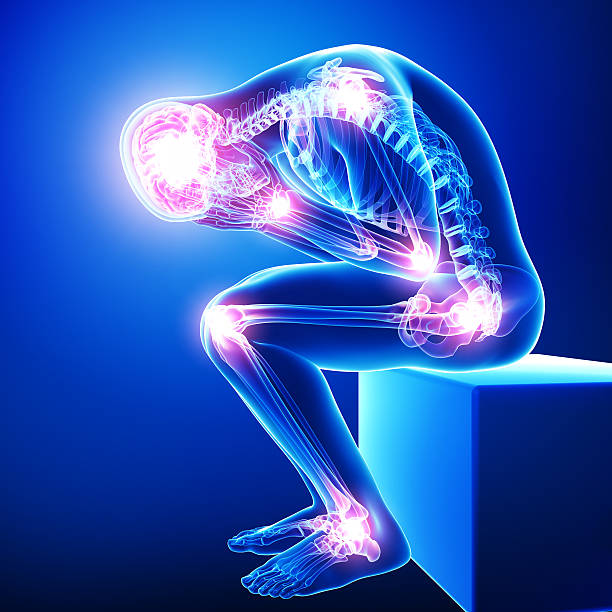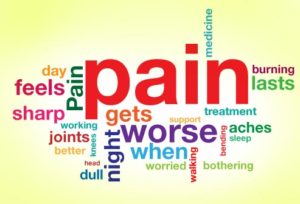
Diagnosed with Cancer? Your two greatest challenges are understanding cancer and understanding possible side effects from chemo and radiation. Knowledge is Power!
Learn about conventional, complementary, and integrative therapies.
Dealing with treatment side effects? Learn about evidence-based therapies to alleviate your symptoms.
Click the orange button to the right to learn more.
- You are here:
- Home »
- Blog »
- side effects ID and prevention »
- Chronic Pain Therapies-
Chronic Pain Therapies-

I am an authority on chronic pain therapies. I say this because I live with many different long-term and late stage side effects from aggressive cancer therapies that have resulted in different types of pain and I have tried to manage my pain with seven of the evidence-based non-conventional therapies for pain listed below.
When I come across a study like the one linked and excerpted below about a chronic pain therapy I write about it in hopes that others can learn from it.
Chronic pain is long standing pain that persists beyond the usual recovery period or occurs along with a chronic health condition, such as arthritis. Chronic pain may be “on” and “off” or continuous. It may affect people to the point that they can’t work, eat properly, take part in physical activity, or enjoy life.
What are evidence-based non-conventional chronic pain therapies ?
Non-conventional therapies for chronic pain often involve approaches that go beyond traditional medical treatments. While it’s important to consult with healthcare professionals before trying any new therapies, here are some non-conventional approaches that people with chronic pain may explore:
- Acupuncture: This traditional Chinese medicine technique involves inserting thin needles into specific points on the body to stimulate energy flow and alleviate pain.
- Chiropractic Care: Chiropractors use manual manipulation of the spine to address musculoskeletal issues, potentially providing relief from certain types of chronic pain.
- Massage Therapy: Massage can help relax muscles, improve circulation, and reduce tension, offering relief for some individuals with chronic pain.
- Mind-Body Techniques:
- Mindfulness Meditation: Practices like mindfulness-based stress reduction (MBSR) and mindfulness meditation can help individuals manage pain by promoting relaxation and acceptance.
- Yoga and Tai Chi: These mind-body practices combine gentle movement, breathing exercises, and meditation, potentially offering benefits for chronic pain management.
- Biofeedback: This technique involves using electronic monitoring to provide individuals with real-time information about physiological processes, helping them learn to control these processes and reduce pain.
- Hypnosis: Hypnotherapy involves guided relaxation and focused attention to induce a state of heightened suggestibility, potentially helping individuals manage pain.
- Herbal Remedies and Supplements: Some people explore the use of herbal supplements, such as turmeric, ginger, or capsaicin cream, for their potential anti-inflammatory and pain-relieving properties. However, it’s crucial to consult with a healthcare professional before using any supplements.
- Physical Therapy: While not entirely non-conventional, physical therapy may involve innovative approaches such as aquatic therapy, dry needling, or specific exercises tailored to the individual’s needs.
- Cognitive Behavioral Therapy (CBT): This form of psychotherapy focuses on changing negative thought patterns and behaviors, helping individuals manage pain by addressing the psychological aspects of chronic pain.
- Aromatherapy: Essential oils and aromatherapy may be used to promote relaxation and reduce stress, potentially contributing to pain relief.
It’s important to note that individual responses to these therapies can vary, and what works for one person may not work for another. It’s advisable to consult with healthcare professionals and specialists who can provide personalized guidance based on the specific nature of the chronic pain condition.
Are you a cancer survivor living with chronic pain? I’m only one person so my experience is only anecdotal of course. If you’d like to learn more about chronic pain therapies with non-opioid therapies let me know- David.PeopleBeatingCancer@gmail.com
Hang in there,
David Emerson
- Cancer Survivor
- Cancer Coach
- Director PeopleBeatingCancer
Researchers Uncover Potential Non-Opioid Treatment for Chronic Pain
“Among the most difficult types of pain to alleviate is neuropathic pain, pain that is usually caused by damage to nerves in various body tissues, including skin, muscle and joints. It can cause patients to suffer feelings like electric shocks, tingling, burning or stabbing. Diabetes, multiple sclerosis, chemotherapy drugs, injuries and amputations have all been associated with neuropathic pain, which is often chronic, sometimes unrelenting and affects millions of people worldwide. Many of the available pain medications are only moderately effective at treating this type of pain and often come with serious side effects, as well as risk of addiction…
The new compound, dubbed FEM-1689, does not engage opioid receptors in the body, making it a possible alternative to existing pain medications linked to addiction. In addition to reducing sensitivity, the compound can help regulate the integrated stress response (ISR), a network of cellular signaling that helps the body respond to injuries and diseases. When well regulated, the ISR restores balance and promotes healing. When it goes awry, the ISR can contribute to diseases such as cancer, diabetes and metabolic disorders…
Highly specific σ2R/TMEM97 ligand FEM-1689 alleviates neuropathic pain and inhibits the integrated stress response
“Significance- Neuropathic pain is a major medical problem that is poorly treated with existing therapeutics. Our findings demonstrate that targeting σ2R/TMEM97 with a modulator reduces pain hypersensitivity in a mouse model with exquisite selectivity.
We also identify integrated stress response (ISR) inhibition as a potential mechanism of action that links the receptor to cellular signaling events that have preclinical and clinical validation for pain relief. Our work suggests that σ2R/TMEM97 can be selectively engaged by specific small molecules to produce ISR inhibition in a subset of cells that are critical for neuropathic pain. σ2R/TMEM97-targeted therapeutics thus have the potential to offer effective pain relief without engagement of opioid receptors…
We and others have shown that σ2R/TMEM97 ligands alleviate mechanical hypersensitivity in mouse neuropathic pain models with a time course wherein maximal antinociceptive effect is approximately 24 h following dosing. We sought to understand this unique antineuropathic pain effect by addressing two key questions:
- do these σ2R/TMEM97 compounds act selectively via the receptor, and
- what is their downstream mechanism on nociceptive neurons?
These results validate σ2R/TMEM97 as a promising target for further development for the treatment of neuropathic pain…
Management of neuropathic pain is a major clinical challenge because available drugs not only have limited efficacy, but they also elicit serious side effects…


